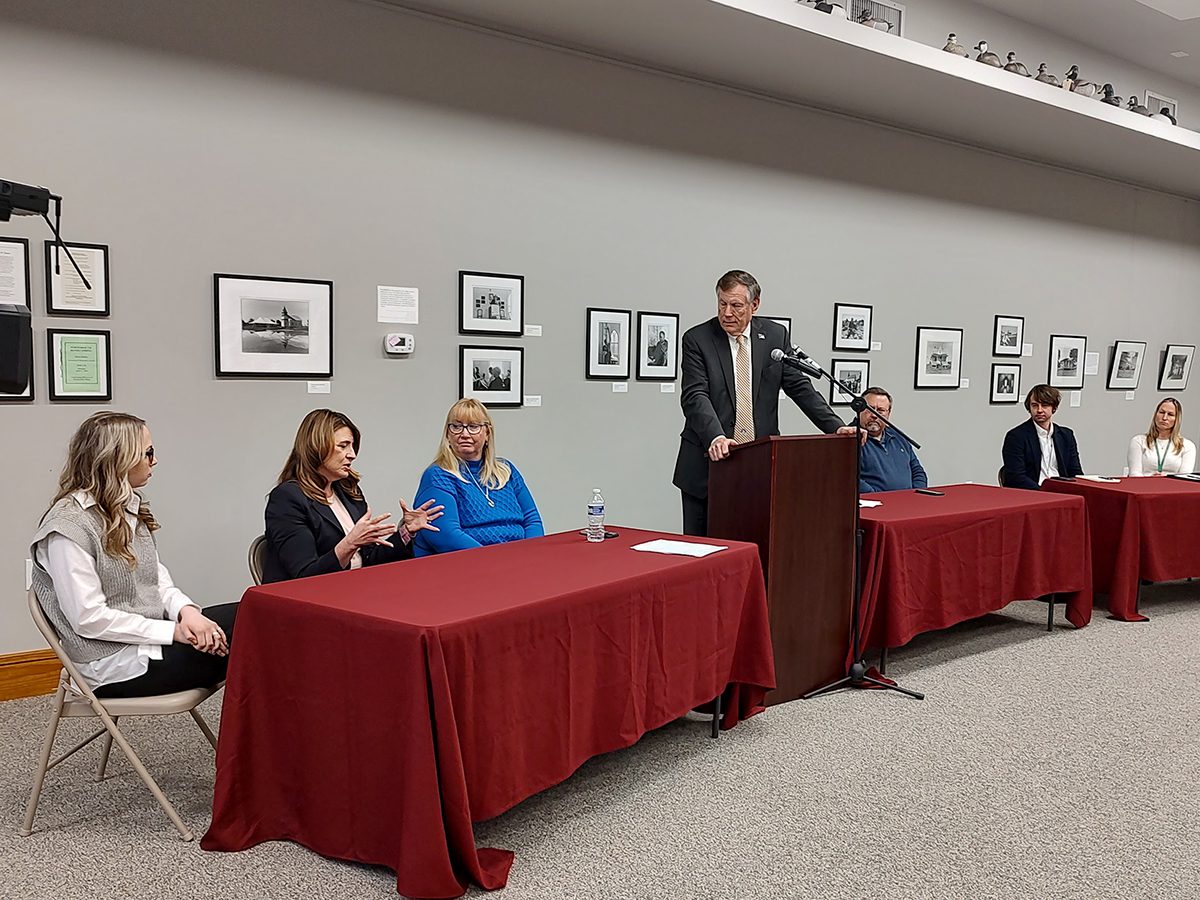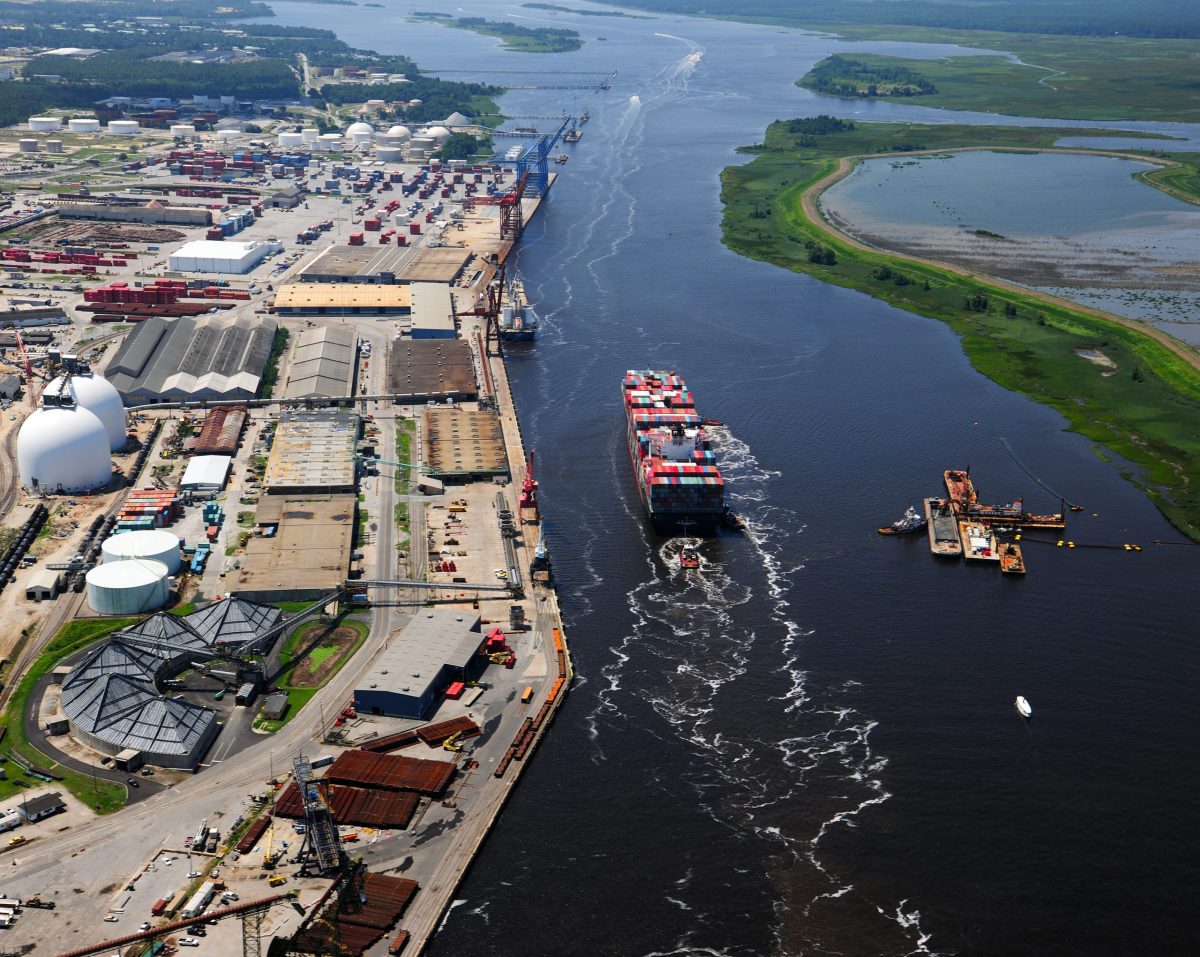
HARKERS ISLAND – From hurricane damage to the current proposed rate increase for homeowners insurance, having a home on the North Carolina coast often comes at a price.
To help property owners better understand their current insurance and what it covers, the Down East Resilience Network, a group focused on adaptation and resiliency for the Carteret County communities, held an all-day community roundtable on insurance at the Core Sound Waterfowl Museum and Heritage Center.
Supporter Spotlight
Insurance specialists, including Insurance Commissioner Mike Causey, were invited to answer questions, and provide information.
Causey told the crowd that making sure your property is more resistant to storms can help hold down insurance costs.
“I think anything we can do to protect the property from wind damage, storm damage, knowing what to do before, during and after a storm is most important in saving lives and holding down our insurance costs,” Causey said, adding there are grant programs for mitigation.
The about 100 who dropped by throughout Wednesday were able to speak with representatives from the state departments of Insurance and Public Safety, and the North Carolina Insurance Underwriting Association, a tax-exempt coastal property insurance pool, and other insurance specialists.
“I want you to understand that everyone lives in a flood zone. The level of risk varies,” Charlotte Hicks said that morning. The flood insurance consultant said that has been her mantra, “everyone is in the flood zone.”
Supporter Spotlight
“I want you to be able to assess your risk. Make a good decision for you. Does every single person in the United States need to buy flood insurance? Probably not, but you need to know what your true level of risk is and whether or not it’s a smart decision for you to make. And I think so many people don’t realize what their risk truly is. And if they did, they would purchase flood insurance and they would not have a problem.”
When asked how a homeowner can best prepare for a natural disaster, Department of Insurance Consumer Complaints Analyst Tim Crawley told Coastal Review that the “number one thing” is to have homeowners insurance in place and understand what’s covered in the policy. He also recommended making sure to keep the structure maintained and let the “cell phone be your friend.”
“Use your phone take a picture of your policy” ahead of the storm, take photos around the home as a way to inventory personal property, he said. “If your house gets decimated, all those papers are gone. You can at least retrieve that from an online cloud.
From a floodplain management perspective, “know your risks,” answered Eryn Futral, a National Flood Insurance Program planner with North Carolina Emergency Management, when asked how a homeowner can best prepare.
“Don’t just look at the flood maps that are available. Look at the other tools that might show you different flooding scenarios depending on storm surge for the type of flooding that you have,” Futral said.
Futral advised asking neighbors and other residents how high waters have been in the past and what types of storm caused flooding. She also recommended online resources such as the North Carolina Flood Inundation Mapping and Alert Network, or FIMAN, a flood-risk information system, and the NC Floodplain Mapping Program.
Department of Insurance Regional Director Jessica Gibbs added that there is a waiting period to buy flood insurance. “Some people will try to buy it right before the hurricane hits, which is never the best.”
It’s also unavailable, once a storm enters a prescribed geographic window. Companies will not put new policies in effect in these situations.
Companies seek big rate hike
Causey, during his remarks, encouraged residents to submit their input during the public comment period ending Feb. 2 on the North Carolina Rate Bureau’s proposed rate increase of 42.2% statewide. The requested increase includes a 99.4% hike for beach areas in Brunswick, Carteret, New Hanover, Onslow and Pender counties.
The most recent rate increase request was in November 2020, when the Rate Bureau sought an overall average increase of 24.5%. That resulted in a settlement between Causey and the Rate Bureau for an overall average rate increase of 7.9%, according to Department of Insurance website.
Causey explained the rate bureau system to the 50 or so at the waterfowl museum Wednesday. The association representing insurance industry interests was created by the North Carolina General Assembly in 1977, and any insurance company that writes business in the state must be a member. When insurance companies want to raise rates on car or homeowners insurance, they’re required by state law to submit a rate filing to the Department of Insurance, which can be 2,000 to 3,000 pages that actuaries must then comb through.
The rate bureau this year is “asking for a whopping increase on homeowners averaging 42% statewide, but is almost 100% on some of our coastal areas, from Carteret down to Brunswick County,” he said.
As required, the department has scheduled a public hearing for 10 a.m. to 4:30 p.m. Monday, Jan. 22, in Raleigh’s Albemarle Building. There is a virtual hearing taking place at the same time.
About 6,000 people have sent letters and emails so far with their opinion on the proposed homeowners rate increase, Causey said.
At the end of the roundtable Wednesday afternoon, Causey reiterated to Coastal Review that “the rate increase is a proposal, and not a done deal. We have a long way to go and the people need to let their voices be heard.”
The public can email comments to 2024Homeowners@ncdoi.gov, or by mail to Kimberly W. Pearce, Paralegal III, by Feb. 2 and addressed to 1201 Mail Service Center, Raleigh, NC 27699-1201.
All public comments will be shared with the North Carolina Rate Bureau. If Department of Insurance officials do not agree with the requested rates, the rates will either be denied or negotiated with the North Carolina Rate Bureau. If a settlement cannot be reached within 50 days, the Commissioner will call for a hearing, according to a release from Causey’s office.
‘A few major factors’
North Carolina Rate Bureau Chief Operating Officer Jarrod Chappell responded to Coastal Review Wednesday in an email that the rate indications in the filing were “being driven by a few major factors reflected in the data,” including rising costs to repair homes.
“We have all seen high rates of inflation in numerous aspects of our lives recently and construction supplies are not immune to that,” Chappell said.
He cited rising labor costs in the construction market since the last filing and noted greater demand than supply in the construction labor market.
“The largest driver overall, however, is reinsurance costs. Homeowners insurance companies must buy reinsurance to cover catastrophic claim exposures and their costs for reinsurance have risen roughly 50% per year over the last 3-4 years,” he said in the email. “This is primarily due to climate change and increased population/exposures in North Carolina. This is especially a problem in the coastal communities where they have the greatest exposure to hurricanes.”
Chappell said it’s the rate bureau’s statutory responsibility to collect data from the insurance companies on any policies written in the state and use that data to determine an adequate rate that will maintain a healthy insurance market for consumers.
“At this point, NCRB has supplied that data to the Commissioner of Insurance with the rate indications. The Commissioner will now review that data and ultimately determine what an appropriate rate should be. Consumers should expect to hear a response from the Commissioner within the next two months where he can either accept the changes as indicated or order a hearing to discuss it further. We have requested an August 1, 2024 effective date for the new rates, but the process often takes much longer than that,” he continued.
As a homeowner, Chappell said he understands the concerns about the numbers they’re seeing in the news. He advised shopping around.
“One thing people should keep in mind is that the Rate Bureau sets a base rate that insurance companies then deviate off of in order to price individual risks accordingly. What that means in the market, is that many homeowners policies are already priced with adequate rates and any change to the base rate will have little to no impact on them,” Chappell said. “We are lucky to have a very competitive insurance market in NC, because it helps keep our rates lower than many other similar states around the country. Maintaining an adequate base rate is critical to keeping that market as competitive as possible.”







